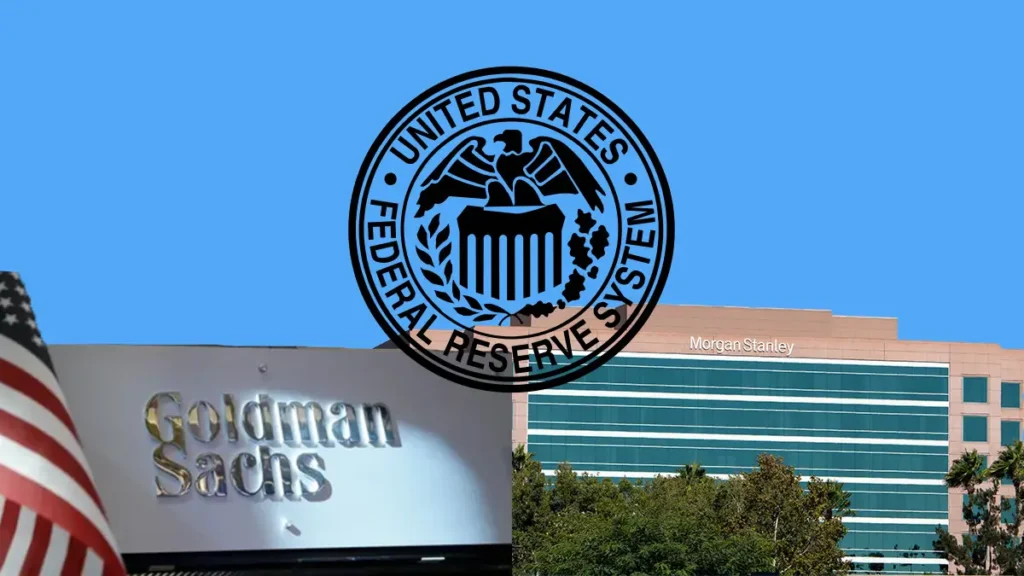Financial giants Morgan Stanley and Goldman Sachs came up with diverging views on the Fed rate cut forecast. Their statements highlighted the uncertainty surrounding the Federal Reserve’s future actions.
Morgan Stanley envisions a proactive approach in their Fed rate cut forecast. On the other hand, Goldman Sachs anticipates a more conservative strategy with delayed cuts.
In the coming years, Morgan Stanley economists predict that the Federal Reserve will significantly lower interest rates due to a decrease in inflation.
Meanwhile, Goldman Sachs Group Inc. analysts anticipate fewer cuts and delayed initiation of the process in their Fed rate cut forecast.
This difference in outlook highlights contrasting perspectives on the future of interest rates.
Morgan Stanley’s Fed rate cut forecast
According to Morgan Stanley’s Fed rate cut forecast, beginning in June 2024, the central bank plans to initiate rate cuts. They anticipate additional reductions in September and every meeting from the fourth quarter onward.
According to their researchers led by Chief US economist Ellen Zentner, each cut will be in 25-basis point increments.
This systematic approach is expected to bring the policy rate down to 2.375% by the conclusion of 2025.
Goldman Sachs’ Fed rate cut forecast
In contrast, Goldman Sachs envisions an initial 25-basis-point reduction in the fourth quarter of 2024.
Economist David Mericle, in the 2024 outlook published on Sunday, anticipates a subsequent quarterly cut through mid-2026. That totals an exact 175 basis points.
This approach aims to establish a target range for rates between 3.5% and 3.75% by the specified timeframe.
Goldman Sachs’ forecasts align more closely with the central bank’s projections.
As of September, Federal Reserve projections indicated two quarter-point cuts for the following year, with the policy rate expected to conclude 2025 at 3.9%, according to the median estimates of policymakers.
The meeting next month will provide Fed governors and regional bank presidents an opportunity to update their forecasts, offering a clearer picture of future monetary policy.
Morgan Stanley anticipated resilience amidst uncertainty
Morgan Stanley’s team envisions a less robust economy, signaling a need for a more substantial easing approach. Although, they do not foresee a recession.
They anticipate a peak in unemployment at 4.3% in 2025, contrasting with the Federal Reserve’s estimate of 4.1%.
Additionally, their outlook suggests slower growth and inflation compared to the expectations of government officials.
According to Zentner’s group, the prolonged presence of high interest rates is expected to exert a continuous drag. That will outweigh the fiscal stimulus and consistently restraining growth below its potential from the third quarter of 2024.
While they maintain the perspective that the Federal Reserve will navigate a soft landing, the diminishing growth trajectory will likely keep concerns about a recession prevalent.
Morgan Stanley suggests that the United States is poised to avoid an economic downturn. They are emphasizing resilience in the job market as employers retain their workforce.
Despite an anticipated slowdown in hiring, the ongoing employment stability is expected to impact disposable income.
Thus it is subsequently influencing spending patterns, according to their Fed rate cut forecast.
Divergent Views of Morgan Stanley and Goldman Sachs
The Morgan Stanley team anticipates the central bank initiating the gradual reduction of quantitative tightening starting in September, with completion targeted for early 2025.
Their Fed rate cut forecast involves the central bank decreasing the runoff caps on Treasuries by $10 billion per month while maintaining the reinvestment of mortgages into Treasuries.
Goldman Sachs anticipates the Federal Reserve will maintain relatively high interest rates due to a higher equilibrium rate.
They argue in their Fed rate cut forecast that the challenges faced since the financial crisis are now in the past.
The likelihood of persistent larger budget deficits is expected to continue, contributing to increased demand.
Goldman’s Mericle describes their forecast as a compromise between Federal Reserve officials who view a lower funds rate as appropriate once inflation concerns are addressed and those who see little need to stimulate an already robust economy.
Read More: Bank of America and Deutsche Bank See Fed Rate Cuts in 2024
Fed Officials Change Stance But Remain Wary of Rate Cut Bets

